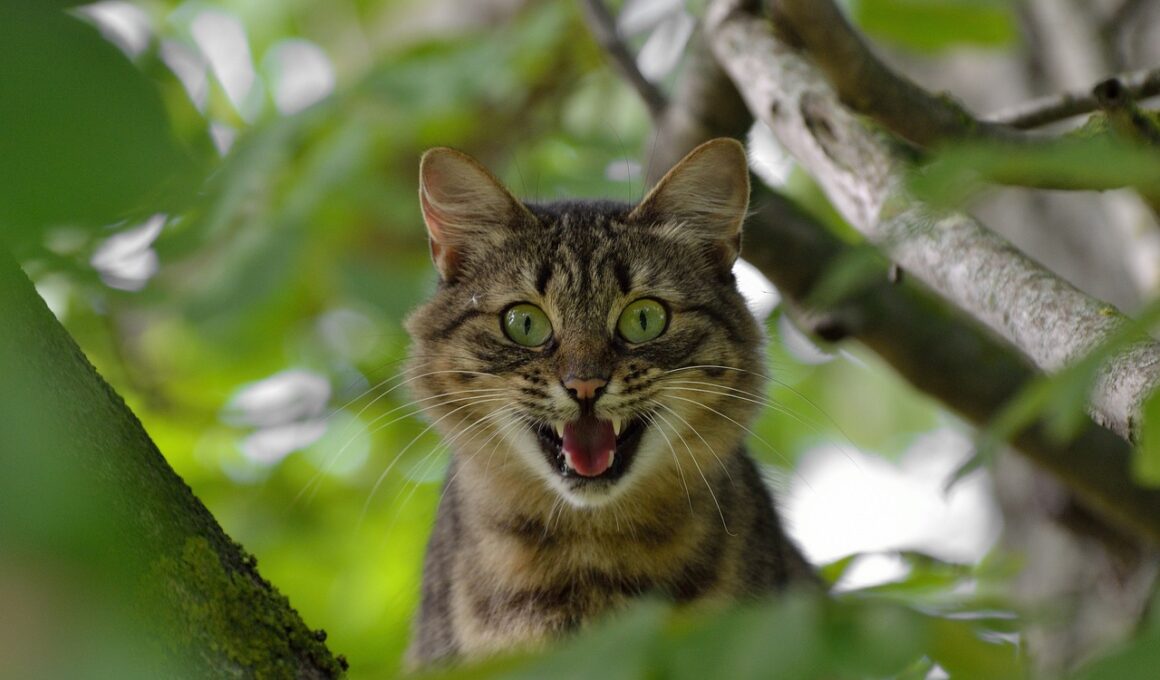Understanding Fear and Stress in Cats: A Comprehensive Guide
Training cats to reduce fear and stress is essential for their overall well-being. Cats can exhibit signs of fear due to environmental changes, past trauma, or an unfamiliar setting. Recognizing these signs can help in designing a training approach. Begin by creating a safe space where your cat feels comfortable. Provide cozy spots and toys, allowing your cat to explore at their own pace. Gradually introduce new elements slowly to avoid overwhelming them. Use treats and positive reinforcement to encourage exploring new spaces or meeting other pets. Consistency is key; practice regularly to build trust. Additionally, spend quality time engaging in play to help reduce stress. Interactive playtime can distract your cat from their fears. Furthermore, ensure their environment is calm by minimizing loud noises and sudden movements. Establish a routine that gives cats a sense of security. Monitoring their behavior closely will provide insights regarding their stress levels. If their fear persists or worsens, consider seeking advice from a veterinarian or animal behaviorist for professional help in managing anxiety.
Signs of Fear and Stress in Cats
Understanding the signs of fear and stress in cats is crucial for effective training. Cats may express their discomfort through various behaviors. Common signs include hiding, excessive grooming, and vocalization. Observe their body language for subtle signals of distress, such as flattened ears or a twitching tail. A frightened cat may also pant or exhibit a rigid posture. Other indicators involve changes in eating habits; decreased appetite can signal anxiety. If your cat is suddenly aggressive or retreating from social interactions, it’s essential to assess their environment. Identify potential stressors within the household causing these reactions. Changes like moving furniture or new pets can significantly impact your cat’s mood. To address these triggers, you can implement gradual introductions to new experiences. Gradually exposing your cat to new environments or experiences allows them to adjust. Consult resources or trainers specialized in feline behavior if you’re unsure how to proceed. Monitoring their behavior consistently will facilitate timely interventions and ensure their mental health is prioritized. A relaxed cat will exhibit a confident demeanor, actively engaging with the surrounding environment and its inhabitants.
Implementing a proper training protocol can help alleviate fear and stress in cats. One effective approach is desensitization, where you gradually expose your cat to the source of their anxiety. Start with very short exposures, slowly increasing duration as they become more comfortable. Pair these experiences with rewards, like treats or affection, to associate positive feelings with the feared object. For instance, if your cat fears a specific room, leave the door ajar and allow them to explore at their own pace. Also, consider employing clicker training for positive reinforcement. Begin with simple commands linked to positive experiences while in a low-stress environment. This technique not only builds trust but also encourages bonding. Moreover, engaging your cat with enriching toys and activities helps distract from anxiety-inducing situations. Create an interactive play routine that keeps their mind active. Providing calming aids, like pheromone diffusers or calming collars, might also assist in reducing stress levels. However, ensure these products are safe and tailored to your cat’s needs. Lastly, regular veterinary check-ups guarantee that underlying medical issues do not exacerbate behavioral problems.
Creating a Calming Environment
Creating a calming environment is vital in reducing fear and stress in cats. Conduct an assessment of your home, identifying areas that may contribute to your cat’s anxiety. Designate quiet spaces where your cat can retreat when feeling overwhelmed. This can include cozy cat beds, shelters, or hidden perches that provide a sense of security. Additionally, consider utilizing soft lighting and calming colors in these areas. These elements can help establish a relaxed area for your cat. Alongside environmental modifications, maintain a predictable routine that minimizes surprises or disruptions. Feed your cats at the same times daily, and designate regular play and relaxation periods. This predictability fosters a sense of security. Also, maintain a fragrance-friendly environment, as strong odors can disturb a sensitive cat’s senses. Natural scents can have soothing effects on cats, such as lavender or chamomile. Create a multi-level cat tree for climbing and vertical space, adding enriching environmental stimuli. This way, your cat will have various places to explore without feeling threatened. Always remember to monitor their reactions to changes and adjust based on their comfort level.
Engaging with your cat through enrichment activities can greatly help diminish their fear and stress levels. Various forms of interactive play are necessary in ensuring physical and mental stimulation. Use toys that encourage movement and mimic hunting behaviors, such as feather wands or laser pointers. Regular play sessions not only foster bonding but also serve as an outlet for pent-up energy. Incorporating puzzle feeders and treat-dispensing toys can further encourage independent play and problem-solving. These activities keep your cat entertained while diverting their focus away from stressors. Additionally, spending time creating DIY projects, such as cardboard fortresses or hideaways, reflects your commitment to their happiness. Furthermore, socialization is key in building confidence in your cat. Expose them to various sights, sounds, and people gradually. New experiences enhance their adaptability, reducing overall anxiety over time. Attend to their body signals regularly during these encounters to avoid overwhelming them. Social interactions should remain positive and rewarding. Observing interactions with children or guests can also yield insights into their behavior. Celebrate gradual progress; every step counts toward better emotional health for your beloved feline.
Consulting Professionals
Sometimes, understanding fear and stress in cats becomes essential to consult with professionals. If your attempts at managing their anxiety yield limited results, don’t hesitate to seek help. A veterinarian specializing in feline behavior can analyze your cat’s situation thoroughly. They may recommend behavioral therapies or medications during this process. Moreover, certified animal behaviorists can provide tailored training plans suited to your cat’s specific needs. Collaborating with these professionals ensures that you’re employing appropriate techniques to support your cat’s emotional well-being. Take note of their recommendations and combine them with positive reinforcement training to maximize results. Consider joining support groups or communities of fellow cat owners facing similar challenges. Sharing experiences and strategies with others can offer valuable insights and encouragement. Each cat is unique; therefore, a diverse approach often proves more effective. Stay patient throughout the training process, as progress can take time. Frequent reassessments of your training methods may be necessary to ensure ongoing success. Ultimately, a calmer, more confident cat reflects the positive changes made in their environment and interactions.
Maintaining a consistent approach is essential for reducing fear and stress in cats. As you embark on this journey, celebrate small victories that indicate progress. Every cat’s timeline for adapting will differ, and patience is paramount. Regularly reflect on the effectiveness of your strategies and adapt them as necessary. Create a record of changes in your cat’s behavior; it will help in recognizing patterns and improvements over time. Pay attention to their reactions in various situations as an indicator of success. Training should be a positive experience for both you and your cat. Engage methods that align with your cat’s personality to enhance their comfort level. Surround them with love and everyday affection, reinforcing their secure feeling within the home. Ensure to regularly assess environmental factors that may lead to anxiety. Changes in the household situation, like new pets or moving furniture, can trigger stress once again. Adapt training strategies to address emotions continually evolving. As time passes, with persistent effort and an understanding of your feline’s needs, you can significantly reduce their fear and stress, contributing to a long and happy life together.


